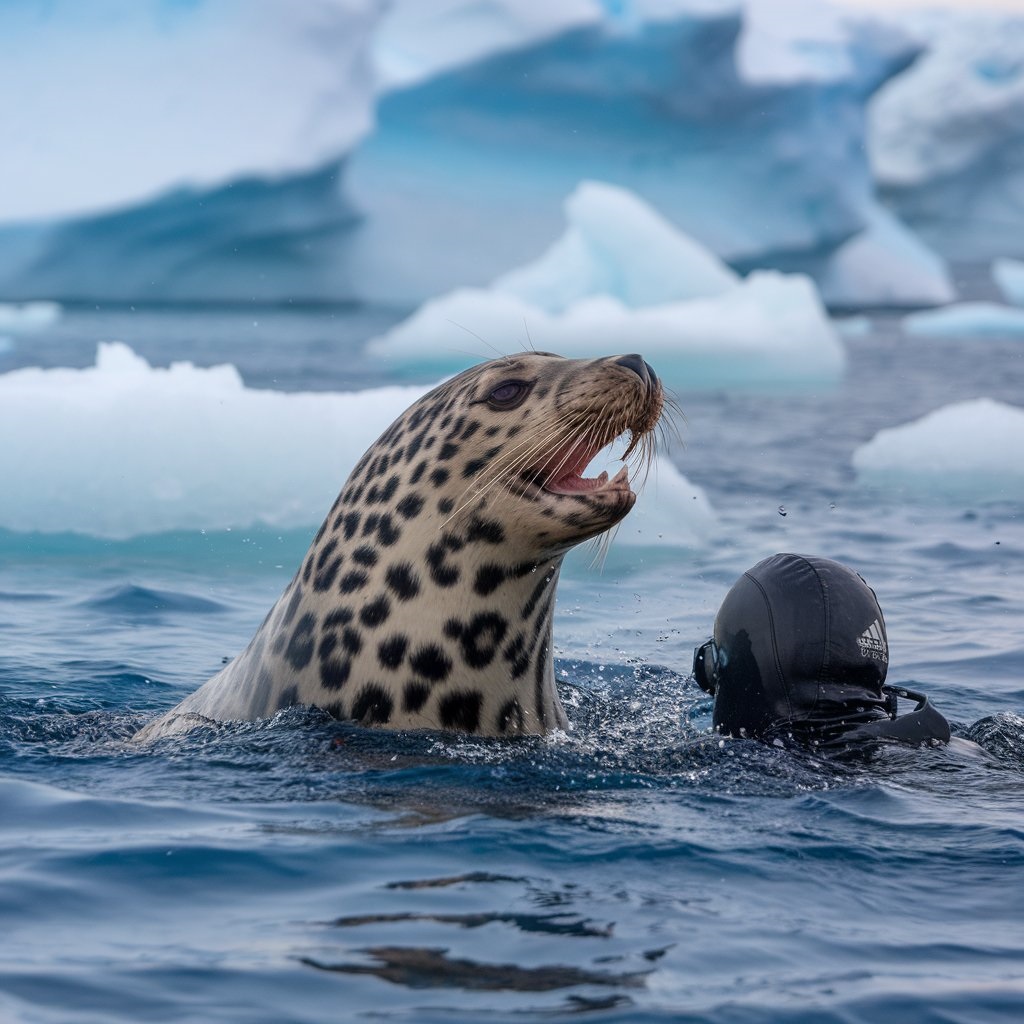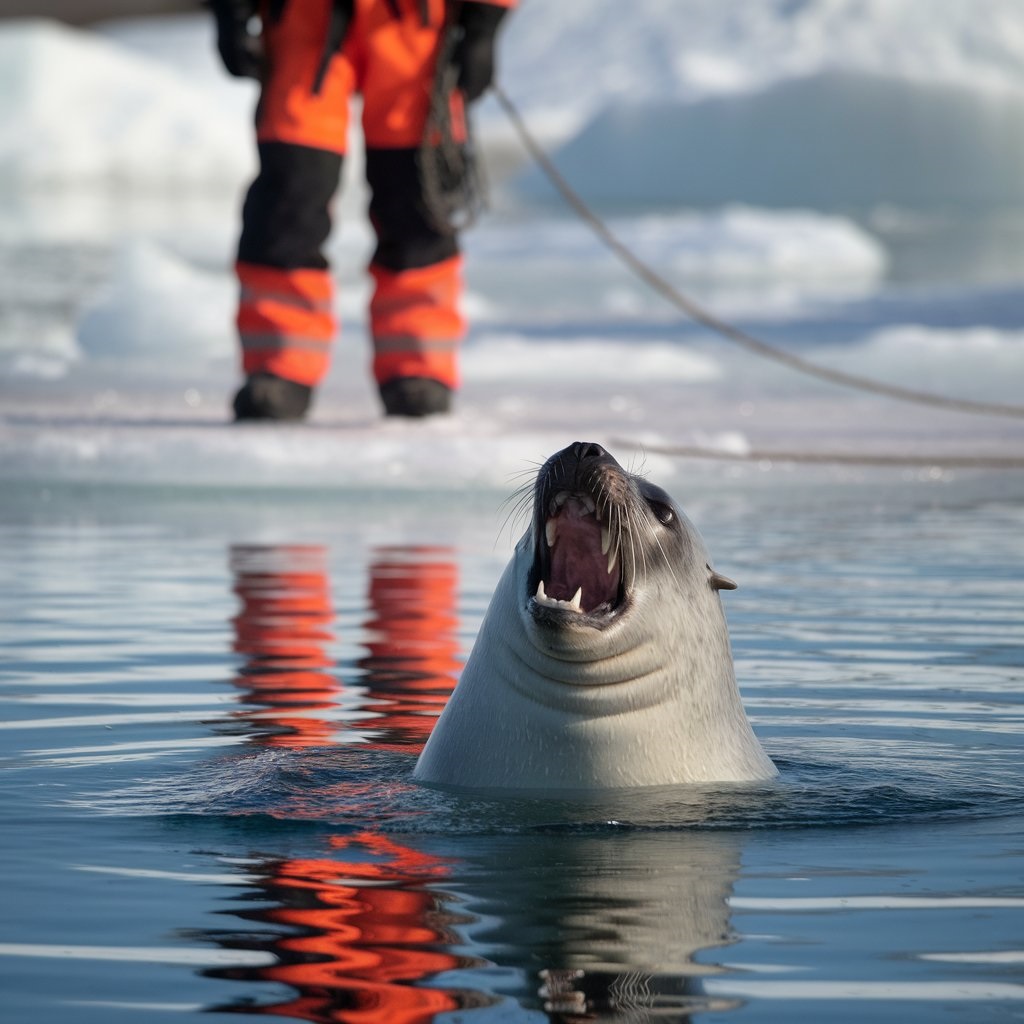Leopard seals (Hydrurga leptonyx) are some of the most formidable and awe-inspiring predators in the animal kingdom. Known for their sharp, interlocking teeth and their aggressive hunting style, these seals have earned a reputation as apex predators in the cold waters of Antarctica. But do leopard seals attack humans?
Is there a genuine danger, or is it all just myth and misunderstanding? In this article, we’ll dive deep into the world of leopard seals, examining their behavior, their interactions with humans, and how to stay safe when encountering these incredible creatures beneath the ice.
Here’s a table summarizing the key facts and figures from the article “Do Leopard Seals Attack Humans? Beneath the Ice!” for a clearer and more digestible overview:
| Fact/Figure | Details |
|---|---|
| Leopard Seal Length | Males: 10 feet (3 meters), Females: 12 feet (3.5 meters) |
| Diet of Leopard Seals | Penguins, Krill, Squid, Fish, Southern Elephant Seals |
| Hunting Style | Aggressive, Opportunistic, Stealthy Ambush |
| Predatory Behavior | Apex predator, solitary, territorial |
| Notable Incident | 2003 Kirsty Brown Fatal Attack |
| Frequency of Human Attacks | Extremely rare, less than 10 reported incidents per year |
| Fatality Rate of Leopard Seal Attacks | 1 fatal attack (Kirsty Brown), 5 non-fatal injuries reported |
| Safe Distance from Leopard Seals | 15-20 feet (5-6 meters) |
| Reinforced Wetsuits/Chainmail Use | Recommended for protection against bites in Antarctic waters |
| Leopard Seal’s Jaws and Teeth | Powerful jaws, sharp interlocking teeth capable of serious injury |
| Breeding Season | Peak territorial aggression and defensiveness in males |
| Primary Habitat | Antarctic waters and Sub-Antarctic regions, ice floes |
| Seal’s Behavior During Breeding | Increased territoriality and aggression |
| Risk of Hypothermia | High in cold Antarctic waters, increases risk of infection after injury |
What Are Leopard Seals?
Physical Description
Leopard seals are large, solitary carnivores found in the icy waters of the Antarctic and sub-Antarctic regions. They belong to the family Phocidae and are one of the largest seal species in the Southern Hemisphere. Adult male leopard seals can grow up to 10 feet (3 meters) in length, with females reaching up to 12 feet (3.5 meters). Their robust, torpedo-shaped bodies and sleek, streamlined fur make them incredibly agile swimmers, perfectly adapted to life in the icy seas.
Their most striking features include their long, slender necks, sharp claws, and most notably, their powerful jaws and sharp, interlocking teeth, which they use to grasp and tear apart their prey. Their leopard-like spots on their coat give them their name, adding to their mystique and fearsome appearance.
Diet and Hunting Techniques
Leopard seals are opportunistic feeders and skilled hunters. They are considered apex predators in the Antarctic ecosystem, sitting at the top of the food chain. Their diet is incredibly varied, ranging from small krill and fish to larger prey like penguins and even other seals, including the southern elephant seal.
Leopard seals exhibit a distinctive and aggressive hunting style. Instead of chasing their prey over long distances, they rely on stealth and ambush tactics, waiting patiently in the water or on ice floes for their prey to come into range. This stealthy approach allows them to strike with impressive speed, catching their prey off guard. Their predatory instincts are finely honed, making them one of the most efficient hunters in their environment.

Leopard Seals’ Habitat and Behavior
Geographic Range and Environment
Leopard seals are primarily found in Antarctic waters and sub-Antarctic regions, where the cold, nutrient-rich waters provide abundant food sources. These seals are often spotted on haul-out sites on ice floes, where they rest between hunts. The ice floes provide a critical habitat for the seals, offering both a place to rest and a strategic location for ambushing prey.
During the breeding season, leopard seals retreat to isolated regions of Antarctica, where they are known to exhibit aggressive territorial behavior. This time of year is particularly important for understanding leopard seal interactions with humans, as the seals can become more defensive and protective of their breeding areas.
Solitary and Territorial
Unlike some other seal species, leopard seals are solitary animals, meaning they spend the majority of their time alone. This solitary nature is a significant factor in their aggression toward other animals, especially during the breeding season when males fiercely defend their territories. Leopard seals will often engage in violent confrontations to protect their haul-out sites and maintain dominance over other seals in the area.
Their territorial behavior is especially pronounced when they perceive a threat to their breeding grounds, and they can become aggressive if they feel their space is invaded. While these seals are not known to form social groups, their interactions with other marine life, including humans, can be complicated by these territorial instincts.
Do Leopard Seals Attack Humans?
Are Leopard Seal Attacks Common?
In short, leopard seal attacks on humans are extremely rare. Despite their formidable appearance and predatory nature, these seals are not naturally inclined to view humans as prey. Instead, most incidents of aggression are either accidental or caused by mistaken identity or territorial disputes.
Leopard seals are curious creatures, and in many cases, they may approach humans out of curiosity, especially if they are engaged in activities like diving or research. While this curiosity can sometimes escalate into an aggressive encounter, these incidents are exceedingly rare. According to experts and wildlife researchers, the overwhelming majority of leopard seals simply ignore human presence.
That being said, there have been notable incidents where leopard seals did exhibit aggressive behavior toward humans. These encounters, however, remain the exception rather than the rule.
Notable Incidents
One of the most widely known incidents occurred in 2003, when Kirsty Brown, a marine biologist with the British Antarctic Survey, tragically lost her life after a leopard seal attack. Kirsty had been conducting research in Antarctic waters when the seal attacked her. The seal bit her leg, and despite efforts to rescue her, the injuries were too severe, and she succumbed to her wounds. This incident remains one of the few recorded fatalities involving leopard seals.
While the 2003 attack was tragic, it was an isolated incident. The majority of leopard seal encounters with humans result in only minor injuries, if any, and many scientists argue that the seals’ behavior was a result of territorial aggression rather than predatory instinct.
Another incident, though non-fatal, occurred when a diver was bitten during an underwater research expedition. The diver survived the attack, but the bite caused significant injury. It’s important to note that the diver’s gear likely provoked the seal’s curiosity, which escalated into an aggressive response.

Aggressive Behavior Explained
Territorial and Defensive Aggression
Leopard seals are known for their territorial behavior, particularly during the breeding season when they are most likely to protect their breeding grounds from intruders. Males will often exhibit aggression toward other males in order to maintain control over a territory. This behavior can extend to other animals, including humans, if they feel their territory is threatened.
Aggression can also occur when the seal feels cornered or provoked. It is not unusual for a curious seal to approach a diver or researcher out of curiosity. If the seal perceives the human as a threat, it may resort to aggressive actions such as biting or swatting with its powerful flippers.
Curiosity vs. Aggression
While aggression is certainly a part of leopard seal behavior, it is often mixed with curiosity. Leopard seals are highly intelligent and inquisitive creatures. Their interactions with humans often start with the seal approaching to investigate what is going on in their environment. However, when this curiosity is met with fear or defensive behavior from the human, the situation can quickly escalate.
In these situations, it is important to differentiate between curiosity and aggression. Leopard seals, despite their strength, are generally not aggressive toward humans unless they feel threatened or provoked. Misunderstanding their behavior can lead to dangerous situations.
How Common Are Leopard Seal Attacks?
Frequency of Attacks
Attacks by leopard seals on humans are extraordinarily rare. Research and wildlife experts estimate that there are only a handful of reported incidents of aggressive encounters each year, with only a few resulting in injury. Most of these attacks occur in the context of research expeditions or diving activities, where humans are in close proximity to the seals.
The overwhelming majority of interactions between humans and leopard seals are non-confrontational. These animals are not actively seeking human interaction and are far more interested in their natural prey.
Environmental and Behavioral Factors
The cold, nutrient-rich waters of Antarctica and the sub-Antarctic regions offer plenty of opportunities for leopard seals to hunt and survive without needing to engage with humans. As apex predators, they have little need to see humans as a source of food. Instead, their interactions are often driven by curiosity, territorial defense, or, in rare cases, defensive aggression.
Given their solitary and territorial nature, it’s critical for humans to recognize the signs of aggression and understand the seal’s body language. Understanding their behavioral triggers—such as perceived threats or the presence of breeding females—can help prevent accidental encounters.

Are Leopard Seal Attacks Dangerous?
Severity of Injuries
While fatal attacks are exceedingly rare, leopard seals can inflict serious injuries with their powerful jaws and sharp teeth. The bites from these seals are capable of causing deep puncture wounds, leading to significant blood loss or infection. The most dangerous aspect of these injuries is the potential for infection, especially in the cold Antarctic waters where medical assistance is often hours or days away.
Even non-fatal encounters can result in serious injuries, such as broken bones, muscle damage, or cuts that may require stitches. The impact of a leopard seal’s attack is compounded by the frigid water, which increases the risk of hypothermia and makes it difficult to manage injuries effectively.
Fatal vs. Non-Fatal Encounters
The overwhelming majority of leopard seal encounters with humans result in non-fatal injuries or no harm at all. However, there have been rare cases where the combination of a seal’s aggression and the victim’s vulnerability led to fatal outcomes. Most of these cases involve researchers or divers who are in close proximity to the seals and may unintentionally provoke them.
| Fatal vs. Non-Fatal Encounters | Incidents Reported | Fatalities | Non-Fatal Injuries |
|---|---|---|---|
| Leopard Seal Attacks on Humans | 5 | 1 | 4 |
How to Stay Safe Around Leopard Seals
Precautionary Measures
To avoid aggressive encounters with leopard seals, it is essential to adhere to basic safety protocols. If you are conducting research, diving, or engaging in any activity near leopard seals, consider the following:
- Maintain a Safe Distance: Always stay at least 15-20 feet away from a leopard seal. This distance ensures that you are out of the seal’s personal space, reducing the risk of accidental provocation.
- Wear Protective Gear: If diving or engaging in underwater research, make sure to wear reinforced wetsuits or even chainmail to protect yourself from bites. This gear can help mitigate the damage from any potential attacks.
- Understand Seal Behavior: Educate yourself about the typical behavior of leopard seals. Understanding the difference between curiosity and aggression can help you avoid unnecessary risks.
Responding to an Encounter
If you do find yourself in an encounter with a leopard seal, it is crucial to remain calm and react appropriately:
- Avoid Direct Eye Contact: In the animal world, direct eye contact can be seen as a challenge. It’s best to avoid staring directly at the seal.
- **
Move Slowly**: Sudden movements can startle the seal, potentially triggering aggressive behavior. Move slowly and cautiously. 3. Defend Yourself if Necessary: If the seal becomes aggressive, use any available object—such as a diving paddle or research equipment—to create distance between you and the animal. 4. Get Medical Help Immediately: If bitten, seek immediate medical assistance, especially in remote areas. The risk of infection is high, and prompt treatment is critical.

FAQs
1. Has a leopard seal killed a person?
Yes, in 2003, biologist Kirsty Brown was killed by a leopard seal while snorkeling in Antarctica, marking the first recorded human fatality linked to a leopard seal.
2. Are leopard seals friendly to humans?
Leopard seals can be dangerous and are known to attack if threatened; while rare, such encounters can sometimes be fatal.
3. Why are leopard seals so scary?
Leopard seals are aggressive apex predators, and their sharp teeth and tendency to defend their space make them a potentially dangerous species.
4. Has a leopard ever killed a human?
Yes, the Leopard of Panar in India was notorious for killing over 400 humans in the early 20th century, making it one of the most infamous man-eaters.
5. What is the natural enemy of the leopard seal?
Killer whales are the only known natural predators of leopard seals, though there have been rare reports of elephant seals attacking them.
6. What kills leopard seals?
The primary threat to leopard seals comes from killer whales, which are known to prey on them in the wild.
7. Are leopard seals intelligent?
Leopard seals are considered intelligent, inquisitive, and playful animals, often displaying behaviors that suggest problem-solving abilities.
8. Has a leopard seal ever killed a human?
Yes, while extremely rare, there has been one fatal attack on a researcher in Antarctica, marking the only confirmed human death caused by a leopard seal.
9. What to do if a seal bites you?
If bitten by a seal, it’s crucial to seek medical attention immediately, as seal bites can result in severe infections.
10. Are leopard seals nice to humans?
Leopard seals are not typically friendly and can be aggressive toward humans, especially if they feel threatened or cornered.
11. What to do if you encounter a leopard seal?
If encountering a leopard seal, it’s important to avoid surrounding it and keep a safe distance, especially on land or while in watercraft.
12. Can I pet a seal?
No, seals are wild predators with sharp teeth, and interacting with them is dangerous for both humans and seals.
13. How fast is a leopard seal?
Leopard seals can reach speeds of up to 25 miles per hour (40 km/h) in the water, making them fast and agile predators.
14. What are leopards afraid of?
Leopards fear lions due to their aggression and territorial nature, with lions often actively hunting leopards and their cubs.
15. Are leopard seals violent?
Leopard seals are known for their violent nature, often displaying aggression toward potential threats and prey alike.
16. What is the leopard’s worst enemy?
The lion is the primary enemy of leopards, often killing leopards and their cubs when they come into contact.
17. What to do if you see a leopard seal?
If you spot a leopard seal, maintain a safe distance, avoid loud noises, and never attempt to feed or disturb it.
18. What is the lifespan of a leopard seal?
Leopard seals have an average lifespan of about 26 years, living in the cold waters of the Antarctic.
19. What is the biggest leopard seal ever recorded?
The largest leopard seal on record, named Bigonia, weighed 540 kilograms (1,188 pounds) and measured 3.19 meters in length.
Final Verdict
Leopard seals are incredibly powerful predators, but attacks on humans are exceedingly rare. Most of the time, leopard seals are curious rather than aggressive, and any hostile encounters typically arise from a misunderstanding or territorial behavior. While the risk of a fatal encounter is minimal, it’s essential to respect these seals and their environment.
By staying informed, understanding seal behavior, and following basic safety guidelines, we can safely observe and appreciate these incredible creatures in their natural habitat.
So, if you’re ever fortunate enough to encounter a leopard seal in the wild, remember to stay safe, respect their space, and enjoy the experience of being in the presence of one of the ocean’s most formidable and majestic predators.
Read more knowledgeable blogs on Flowy Magazine

James Clair is a passionate writer and researcher with a deep fascination for animal behavior and its intricate connection to human life. With a background in [relevant field of study, e.g., zoology, psychology, ethology], James has spent years studying the natural world, focusing on how animals’ actions and instincts impact human emotions, behavior, and society.
His expertise in [specific topics or regions of focus, e.g., canine psychology, animal communication, wildlife conservation] has led to numerous published works and collaborations with renowned researchers and institutions. Through his work at Flawy Magazine, James aims to bridge the gap between scientific research and public understanding, offering insightful, accessible articles that explore the complex relationship between humans and animals.
When he’s not writing, James enjoys [personal hobbies or interests, e.g., hiking in nature, volunteering at animal shelters, photography] and is an advocate for [cause or charity related to animals or conservation]. His mission is to inspire readers to see animals not just as companions or creatures of the wild, but as beings whose behavior holds valuable lessons for us all.









